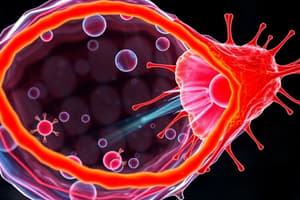Podcast
Questions and Answers
What is the primary function of osmosis in cellular processes?
What is the primary function of osmosis in cellular processes?
- Producing energy for the cell
- Maintaining cell shape and volume (correct)
- Facilitating cell division
- Regulating body temperature
What type of solution has a lower concentration of solutes compared to another solution separated by a selectively permeable membrane?
What type of solution has a lower concentration of solutes compared to another solution separated by a selectively permeable membrane?
- Hypotonic (correct)
- Hypertonic
- Isotonic
- Equilonic
What is the purpose of osmosis in the kidneys?
What is the purpose of osmosis in the kidneys?
- Storing nutrients
- Regulating blood pressure
- Removing waste and excess ions from the blood (correct)
- Producing urine
What is the result of osmosis in a hypertonic solution?
What is the result of osmosis in a hypertonic solution?
What is an application of osmosis in food preservation?
What is an application of osmosis in food preservation?
What factor increases the rate of osmosis?
What factor increases the rate of osmosis?
What is the result of osmosis in an isotonic solution?
What is the result of osmosis in an isotonic solution?
What is the process of removing salt and other impurities from seawater using osmosis?
What is the process of removing salt and other impurities from seawater using osmosis?
Flashcards are hidden until you start studying
Study Notes
Osmosis
Definition
Osmosis is the movement of water molecules through a selectively permeable membrane from an area of high concentration to an area of low concentration, resulting in equalization of solute concentrations on both sides of the membrane.
Types of Osmosis
- Isotonic: The concentration of solutes is equal on both sides of the membrane, resulting in no net movement of water molecules.
- Hypotonic: The concentration of solutes is lower on one side of the membrane, resulting in water molecules moving into the solution to dilute the solutes.
- Hypertonic: The concentration of solutes is higher on one side of the membrane, resulting in water molecules moving out of the solution to concentrate the solutes.
Importance of Osmosis
- Cellular Processes: Osmosis plays a crucial role in various cellular processes, such as maintaining cell shape, regulating cell volume, and facilitating nutrient uptake and waste removal.
- Biological Systems: Osmosis is essential for various biological systems, including the kidneys, where it helps remove waste and excess ions from the blood.
Osmosis in Real-World Applications
- Desalination: Osmosis is used in reverse osmosis to remove salt and other impurities from seawater, making it suitable for drinking.
- Dialysis: Osmosis is used in dialysis to remove waste products from the blood in patients with kidney failure.
- Food Preservation: Osmosis is used to preserve food by controlling the concentration of solutes, preventing bacterial growth and spoilage.
Factors Affecting Osmosis
- Concentration Gradient: The greater the concentration gradient, the faster the rate of osmosis.
- Surface Area: Increasing the surface area of the membrane increases the rate of osmosis.
- Temperature: Increasing the temperature increases the rate of osmosis.
Osmosis
Definition
- Osmosis is the movement of water molecules through a selectively permeable membrane from high to low concentration, equalizing solute concentrations on both sides.
Types of Osmosis
- Isotonic: Equal solute concentrations on both sides, no net water movement.
- Hypotonic: Lower solute concentration on one side, water molecules move in to dilute solutes.
- Hypertonic: Higher solute concentration on one side, water molecules move out to concentrate solutes.
Importance of Osmosis
- Cellular Processes: Maintains cell shape, regulates cell volume, and facilitates nutrient uptake and waste removal.
- Biological Systems: Essential for kidney function, removing waste and excess ions from blood.
Osmosis in Real-World Applications
- Desalination: Reverse osmosis removes salt and impurities from seawater, making it drinkable.
- Dialysis: Osmosis removes waste products from blood in patients with kidney failure.
- Food Preservation: Controls solute concentration to prevent bacterial growth and spoilage.
Factors Affecting Osmosis
- Concentration Gradient: Greater gradient increases osmosis rate.
- Surface Area: Increasing membrane surface area increases osmosis rate.
- Temperature: Increasing temperature increases osmosis rate.
Studying That Suits You
Use AI to generate personalized quizzes and flashcards to suit your learning preferences.





